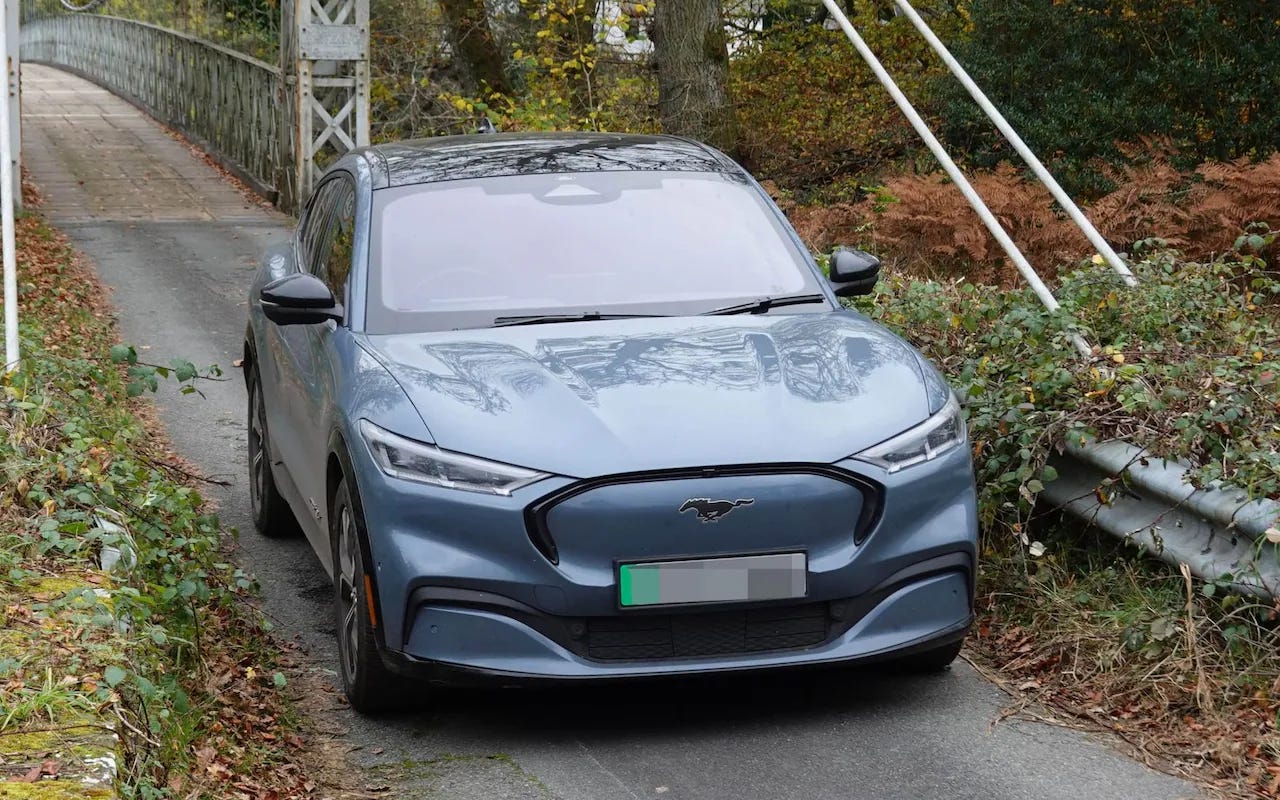High-mileage electric car usage is working out almost twice as expensive as petrol
What’s promised isn’t always what you get with electric cars – my 11,000 miles in Ford Mustang Mach-E proved it’s far from an EV panacea
By Andrew English
Perhaps autumn half-term week was not the best time for driving long distances in an EV on largely unplanned routes, but then family life is like that, full of the unexpected, joyful and sometimes sad.
The first thing I learnt during 11,000 miles in the Mach-E was that it isn’t a “proper” Mustang. Secondly, if you regularly cover high mileage in an EV, you need to travel when everyone else isn’t to avoid queuing at chargers.
Fortunately, now that my three-month eschewal of fossil fuels is over, I’m able to use my Honda Civic Type R for long personal journeys, although the Ford is still pressed into service when work calls.
Recently, a family illness was a force majeure and the Civic was being serviced so the Ford was the only transport. Unfortunately, no amount of planning could avoid bank-holiday travel and the armada of electric vehicles needing to charge.
It looked as though Gridserve hadn’t done much planning, either. Of its 24 high-current chargers at Exeter services, eight were out of service. It was chaos.
“I’m glad my boss will be doing this next week so he can see what it’s like,” said Gridserve’s Matt Sidwell, who was doing sterling work trying to instil order to the rambunctious queuing system. With no space to stack cars, no signposting and people constantly trying to push in, he was fighting a losing battle.
“The thing that drives me crazy is the people who stay on the charger to get a 100 per cent charge,” he said. “It’s virtually impossible to achieve and takes so long because the charger is only trickling current in at that point.”
I looked enviously at the rows of Tesla-only chargers, most of them unoccupied.
It took 45 minutes for a charger to become vacant. I plugged in the Ford, unwrapped a bacon sandwich and wondered why Colmans no longer sells mustard in tubes.
There was a sharp tap at the window. “The chargers are rated at 175kWh,” said an elderly motorist who’d emerged from a Nissan Leaf and was peering at the charger display. “You’re only getting 80.”
I didn’t tell him I’ve rarely seen more than 80 and even then not for long, although the Ford’s DC fast charging is rated at 150kWh.
I just wish Ed Miliband, the energy security minister, was there so I could stuff my bacon sandwich where the sun doesn’t shine, but he was packing his swimmers for the COP conference in Baku.
With the Mustang averaging 2.8 miles per kWh on motorways, it has an effective range of 250 to 270 miles (from the 91kWh lithium-ion battery) against a claim of 372 miles (although, to be fair, Ford advertises the Mach-E with a “motorway range” of 306 miles).
To eke out the range I travel everywhere with the heater off, which currently demands a substantial coat, hat and gloves. I’m writing to Santa for thick socks this Christmas.
As any long-distance EV user will tell you, speed, hills and lower temperatures are the chief enemy of battery range. I recently learnt from Moni Islam, Audi’s chief aerodynamicist, that in the official Worldwide Harmonised Light Vehicle Test Procedure, 40 per cent of the battery usage is occupied by aerodynamic drag – but if, like me, you only do long motorway journeys, that figure rises to nearer to 60 per cent.
Like any experienced EV user, I’m well acquainted with the rapid falling of predicted range against actual journey distance. For example, when I started with a 95 per cent charge, which had a predicted range of 269 miles, the Exeter Gridserve chargers seemed easily within range. The Ford showed an 85-mile excess over the distance calculated by Waze.
Yet, an hour and a half into the journey, the excess had dropped to 48 miles and, after three hours, I crawled into the services with less than 12 per cent charge.
My poorly mother proved to be in rather better health than the UK charging system on that day. She was interested in the Ford parked outside.
“So, how much does it cost to run?” she asked, ever the mathematician.
I grabbed some paper.
While I once had to pay a whopping £1.12 per kWh at a Shell Recharge station, in general fast charging averages at between 85 and 90p per kWh. On a long motorway journey, the Ford averages between 2.6 and 2.8 miles per kWh, which is by no means unexceptional in large battery SUVs I’ve tested. Using the more generous figures in both cases, the Ford is costing at least 30p per mile for the electricity alone.
“And what about your Honda?” she continued. My scrap of paper was getting crowded, but at similar speeds my Civic Type R will return about 34 miles per gallon, which means that the fuel cost per mile is about 16p. She gave me a hard stare.
“Is it worth it?”
Zero tailpipe emissions
Good question, because while there are zero tailpipe emissions, charging an EV has a C02 implication in electricity generation. The actual motorway range and the current UK figure for generating CO2 shows that, on a long run, the Ford produces CO2 at a rate of 43g/km. There are petrol plug-in hybrid cars that produce less than half that amount; even the Toyota Yaris hybrid produces only 92g/km.
But let’s not make the Ford the villain of the piece. These are issues that affect anyone covering high mileages while relying on the roadside charging network.
The Mustang Mach-E is the type of car that Ford used to make: powerful, robust, likeable, but not fantastically efficient. Volvo was the same thing, just more upmarket.
And, frankly, if you travel quickly in any EV, the range plummets. In the days of combustion that merely meant a little more on your fuel bill, but these days it means hours at a charging point, time that no one pays me for.
As so often with electricity or electric cars, what’s promised isn’t always what you get – and that affects your wallet and the environment…
Go paid at the $5 a month level, and we will send you both the PDF and e-Pub versions of “Government” - The Biggest Scam in History… Exposed! and a coupon code for 10% off anything in the Government-Scam.com/Store.
Go paid at the $50 a year level, and we will send you a free paperback edition of Etienne’s book “Government” - The Biggest Scam in History… Exposed! OR a 64GB Liberator flash drive if you live in the US. If you are international, we will give you a $10 credit towards shipping if you agree to pay the remainder.
Support us at the $250 Founding Member Level and get a signed high-resolution hardcover of “Government” + Liberator flash drive + Larken Rose’s The Most Dangerous Superstition + Art of Liberty Foundation Stickers delivered anywhere in the world. Our only option for signed copies besides catching Etienne @ an event.







They are nothing than DATA gathering devices to collect and sell to mthe security state (big Texch) the NASADAQ big 7. If you knew about the GPS design of trick track andtrace, every digit collected is bought by Taxpayer. Electric prison machines are easily controlled by vendor, where combustible engine devices still allow some freedom, but with more automation of sensor control, the noose is tightened. I was fortunate to see the early business model of GPS in early 90's. The goose that laid the golden egg, every human cab be tracked and sold for profit.